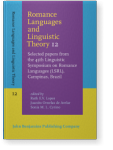Chapter 1
Modality, presupposition and discourse
The meaning of European Portuguese afinal and Italian alla fine
This paper provides a semantic analysis of the particles afinal (European Portuguese) and alla fine (Italian) in terms of the notion of truth unpersistence, which can be situated at the intersection of epistemic modality and discourse structure. In the analysis proposed, the particles are propositional operators and require that the truth of a proposition p* fail to persist through a temporal succession of epistemic states, this proposition being incompatible with the prejacent, and that the interlocutors share knowledge of a previous epistemic attitude toward p*. We analyze two main cases (plan-related and non plan-related propositions) and also show that these particles are indexical to one (or more) epistemic agent(s) and allow for shifts in perspective.
Article outline
- 1.Introduction
- 2.Empirical data from European Portuguese and Italian
- 2.1Plan-related propositions
- 2.2Non plan-related propositions
- 2.3Temporal uses of alla fine
- 3.Analysis of the data
-
4.Perspectival shifts
- 5.Conclusion
-
Notes
-
References
-
Corpora used
References (15)
References
Amaral, Patrícia, Craige Roberts, and E. Allyn Smith. 2007. “Review of The Logic of Conventional Implicatures by Chris Potts.” Linguistics and Philosophy 30: 707–749. 

Amaral, Patrícia, and Fabio Del Prete. 2014. “On Truth Persistence: A comparison between European Portuguese and Italian in relation to sempre
.” In Variation within and across Romance Languages. Selected papers from the 41st Linguistic Symposium on Romance Languages, ed. by Marie-Hélène Côté, and Eric Mathieu, 135–154. Amsterdam: John Benjamins.
Amaral, Patrícia, and Fabio Del Prete. 2016. “On truth unpersistence: at the crossroads of epistemic modality and discourse”, Natural Language and Linguistic Theory 34 (4): 1135–1165. 

Baroni, Marco, Silvia Bernardini, Federica Comastri, Lorenzo Piccioni, Alessandra Volpi, Guy Aston, and Marco Mazzoleni. 2004. “Introducing the “la Repubblica” corpus: A large, annotated, TEI(XML)-compliant corpus of newspaper Italian.” In Proceedings of LREC 2004.
Brito, Ana Maria. 2001. “Clause Structure, Subject Positions and Verb Movement. About the Position of Sempre in European Portuguese and Brazilian Portuguese.” In Romance Languages and Linguistic Theory 1999. Selected papers from ‘Going Romance’ 1999, ed. by D’hulst, Yves, Johan Rooryck, and Jan Schroten, 63–85. Amsterdam: John Benjamins.
Chierchia, Gennaro, and Sally McConnell-Ginet. 1990. Meaning and Grammar. Cambridge: The MIT Press.
Fiéis, Alexandra. 2010. “On the Position of Sempre in Medieval Portuguese and in Modern European Portuguese.” The Linguistic Review 27: 75–105. 

Gonzaga, Manuela. 1997. Aspectos da Sintaxe dos Advérbios em Português. M.A. Dissertation, Lisboa: FLUL.
Gutzmann, Daniel. 2013. “Expressives and Beyond: An Introduction to Varieties of Use-Conditional Meaning.” In Beyond Expressives. Explorations in Use-Conditional Meaning. Current Research in the Semantics Pragmatics-Interface (CRiSPI) 28, ed. by Gutzmann, Daniel, and Hans-Martin Gärtner, 1–58. Leiden: Brill. 

Lopes, Ana C. M. 2011. “La polyfonctionnalité du marqueur discursif ‘afinal’ en portugais européen.” In Discourse markers in Romance languages, Oslo Studies in Language 3(1), ed. by E. Khachaturyan, 131–140.
Roberts, Craige. 1996. “Information Structure in Discourse: Towards an Integrated Formal Theory of Pragmatics.” In OSU Working Papers in Linguistics, Vol. 49., ed. by Jae-Hak Yoon, and Andreas Kathol, 91–136. Columbus, Ohio.
Santos, Diana, and Paulo Rocha. 2001. “Evaluating CETEMPúblico, a free resource for Portuguese.” In Proceedings of the 39th Annual Meeting of Association for Computational Linguistics, 450–457.
Tonhauser, Judith, David I. Beaver, Craige Roberts, and Mandy Simons. 2013. “Toward a taxonomy of projective content.” Language 89 (1): 66–109. 

Corpora used
La Repubblica corpus, a corpus of Italian newspaper text ([URL])
CETEMPúblico: Santos, Diana, and Paulo Rocha. 2001 CETEMPúblico LDC2001T62. Web Download. Philadelphia: Linguistic Data Consortium, 2001.
Cited by (1)
Cited by one other publication
Amaral, Patrícia
2018.
Expressive meaning. In
Handbuch Pragmatik,
► pp. 325 ff.

This list is based on CrossRef data as of 16 july 2024. Please note that it may not be complete. Sources presented here have been supplied by the respective publishers.
Any errors therein should be reported to them.
